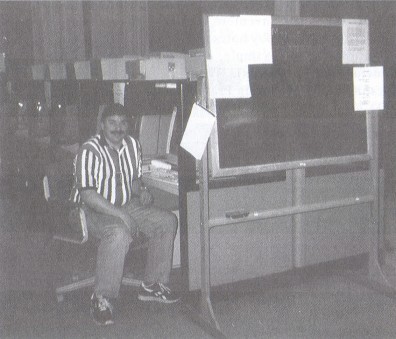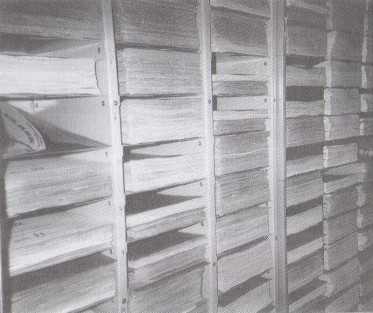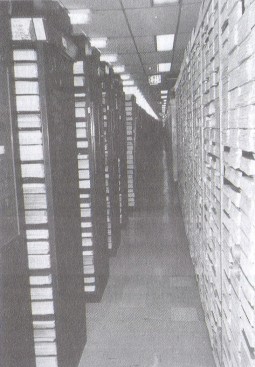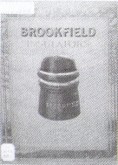A Trip to the Patent and Trademark Office
by Rick Soller
Reprinted from "Crown Jewels of the Wire", May 2002, page 13
For many collectors, the ultimate experience is to dig at an insulator
factory site, search an old threadless telegraph line, or poke through the
shelves of a utility company but for me it is to roam endless stacks of material
in some archive of information. While attending a conference related to my
teaching, I had that experience when I was able to spend two-and-a-half days in
the Patent and Trademark Office (PTO) in Washington, D.C. in May.

Banks of work stations in the Patent & Trademark Office.
Rick Soller at
one.
Since I was on a break, I could leave for the conference several days early.
I wanted to look up foreign patents and the PTO had a great collection of these.
My wife, Nedra, drove me to the train station which took me to downtown Chicago where I walked two blocks to catch the
Elevated train to the airport where I boarded a plane to Baltimore and rented a
car to drive to Arlington, Virginia, across the river from D.C. On the return
trip, I regretted not taking a more direct route since I had to lug my suitcase
loaded with photocopies for long distances as a result. It was like carrying two
Chicago phone books around with me.
Even though I left at 8:30 in the morning
and the flight was less than three hours long, it was 4:45 in the afternoon
before I got to the PTO. I figured I only had 15 minutes to look around but I
was excited and thought I might at least get a lay of the land. I was delighted to
learn that even though the office containing foreign patents closed at 5 p.m.,
the first floor office housing U.S. patents was open until 8 p.m. With some help
from the reference desk, I quickly found where the U.S. patents were located and
went to work.
The floor housing U.S. patents is designed to help patent
examiners, attorneys, and inventors find relevant patents. As a result, patents
are put into cubby holes according to classes and subclasses. Most insulators,
for example, are found in class 174 (Electricity: Conductors and Insulators).
Within this class, there are 212 subclasses including Lightning Protection
(subclass 2), Lightning Protection-Rods (subclass 3), Insulators-Mid-line Spacers (subclass 146), and
Insulators-With Terminal Elements-Pin Type (subclass 194). If a patent is
relevant to multiple classes and subclasses, a copy is made and the patent can
be found in each location.

Cubby holes in the Patent & Trademark Office.
The amount of space this cross-referencing requires
is immense. I estimate that the first floor is about the size of a football
field. I counted 117 rows of shelves that spanned two buildings. Each row is
divided into two sections by a path down the middle. Each section has 63 columns
of cubby holes. Each column has 28 cubby holes. When you do the math, there are
412,776 slots that a patent could be filed in. To get at a particular cubby
hole, there is a map that tells you what row the class is in. Above each column
in that row is a card that tells you what patent subclass is filed in each of
the 28 slots. Most subclasses take numerous slots. Physically, each row is a
narrow 22 inches wide making it difficult to turn around or get at patents on
the bottom.

The long rows of shelves on the left
and cubby holes on the right in the
Patent & Trademark Office.
I thankfully learned that I did not need to manually copy patents I
found. Once I found a patent number, for 25 cents a page I could get a laser
copy of the patent by using a work station near the entrance. My first order of
business, then, was to pull all the patents on a subclass that interested me,
write down all the patent numbers, and print them. After writing down over 1100
patent numbers, I knew I would have to be selective since the average patent was
3 pages long and I wasn't prepared to spend over $800 on making copies. That was
like leaving an E.C.& M. behind so you could carry a California Electrical
Works insulator out of the woods.
On day two, I was at the PTO when it opened and immediately went to the
second floor to look at foreign patents. Here the work was much more
labor-intensive. Indexes had to be used to find the patent numbers and patents
had to be manually copied. I was also disappointed that only abbreviated patents
were available for most countries. French patent journals only had a one-line
description of the item and no picture. Some patent journals did not go back to
the beginning as I expected or were in storage where it would cost $25 to have
them brought to this location. Still, I did not run out of things to do and
managed to get through 10 years of British abbreviated patents.

I also explored
the library on this floor and found some treasures. My favorite was an original
copy of the 1912 Brookfield catalog. What shocked me was that the insulator
pictured on the cover was dark green rather than being the same color as the
cover as on the catalog reprint I own. The picture of the factory inside was
also green. The library also had a 1930 Thomas catalog, a copy of The Locke
Story, some obscure conference reports (e.g., Digest of Literature on Dielectrics) , a few issues of the NGK Review, and some books I would like to get like
an English book titled, "The History of Electric Wiring."
Half of my
suitcase on the return trip was filled with photocopies. I'm looking forward to
reading them, trying to contact inventors who may still be alive, matching the
patent to the insulators in my basement, and putting some on my web page. At one
point, I though I might just make a book out of them but I now realize there are
just too many of them and more that I could get. I really only scratched the
surface there and think it would be a great idea if, just like with the
Smithsonian, some NIA members would coordinate some research there. On my way
home, I took a bump from the airline in exchange for a free future flight so I
would be willing to return for another round at the PTO.
| 